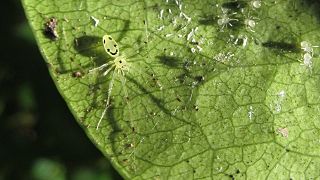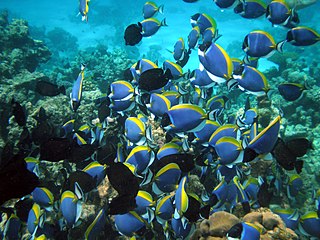Related Research Articles

Predation is a biological interaction where one organism, the predator, kills and eats another organism, its prey. It is one of a family of common feeding behaviours that includes parasitism and micropredation and parasitoidism. It is distinct from scavenging on dead prey, though many predators also scavenge; it overlaps with herbivory, as seed predators and destructive frugivores are predators.

Foraging is searching for wild food resources. It affects an animal's fitness because it plays an important role in an animal's ability to survive and reproduce. Foraging theory is a branch of behavioral ecology that studies the foraging behavior of animals in response to the environment where the animal lives.

In biology, polymorphism is the occurrence of two or more clearly different morphs or forms, also referred to as alternative phenotypes, in the population of a species. To be classified as such, morphs must occupy the same habitat at the same time and belong to a panmictic population.
Frequency-dependent selection is an evolutionary process by which the fitness of a phenotype or genotype depends on the phenotype or genotype composition of a given population.

The scaly-breasted munia or spotted munia, known in the pet trade as nutmeg mannikin or spice finch, is a sparrow-sized estrildid finch native to tropical Asia. A species of the genus Lonchura, it was formally described and named by Carl Linnaeus in 1758. Its name is based on the distinct scale-like feather markings on the breast and belly. The adult is brown above and has a dark conical bill. The species has 11 subspecies across its range, which differ slightly in size and color.
Balancing selection refers to a number of selective processes by which multiple alleles are actively maintained in the gene pool of a population at frequencies larger than expected from genetic drift alone. Balancing selection is rare compared to purifying selection. It can occur by various mechanisms, in particular, when the heterozygotes for the alleles under consideration have a higher fitness than the homozygote. In this way genetic polymorphism is conserved.

A herd is a social group of certain animals of the same species, either wild or domestic. The form of collective animal behavior associated with this is called herding. These animals are known as gregarious animals.

The lemon shark is a species of shark from the family Carcharhinidae and is classified as a Vulnerable species by the International Union for the Conservation of Nature. Lemon sharks can grow to 3.4 metres (11 ft) in length. They are often found in shallow subtropical waters and are known to inhabit and return to specific nursery sites for breeding. Often feeding at night, these sharks use electroreceptors to find their main source of prey, fish. Lemon sharks enjoy the many benefits of group living such as enhanced communication, courtship, predatory behavior, and protection. This species of shark gives birth to live young, and the females are polyandrous and have a biennial reproductive cycle. Lemon sharks are not thought to be a large threat to humans; there have been 10 recorded bites, none of which were life-threatening. The lemon shark's life span is unknown, but the average shark is 25 to 30 years old.
Apostatic selection is a form of negative frequency-dependent selection. It describes the survival of individual prey animals that are different from their species in a way that makes it more likely for them to be ignored by their predators. It operates on polymorphic species, species which have different forms. In apostatic selection, the common forms of a species are preyed on more than the rarer forms, giving the rare forms a selective advantage in the population. It has also been discussed that apostatic selection acts to stabilize prey polymorphisms.

Optimal foraging theory (OFT) is a behavioral ecology model that helps predict how an animal behaves when searching for food. Although obtaining food provides the animal with energy, searching for and capturing the food require both energy and time. To maximize fitness, an animal adopts a foraging strategy that provides the most benefit (energy) for the lowest cost, maximizing the net energy gained. OFT helps predict the best strategy that an animal can use to achieve this goal.

Lampropholis delicata, the delicate skink, dark-flecked garden sun skink, garden skink, delicate garden skink, rainbow skink or plague skink, or the metallic skink is native to Australia and invasive in New Zealand and Hawaii where it is commonly found in gardens. The species is known for their color dimorphism between males and females; striped morphs and non-striped morphs exist in this species, however the stripe is less pronounced in males. This species' diet consists of a wide range of prey, such as spiders, bees, larvae, and termites. Mating occurs in the late summer and generally one clutch of 2 to 4 eggs are laid per year by each female.

Theridion grallator, also known as the Hawaiian happy-face spider, is a spider in the family Theridiidae that resides on the Hawaiian Islands. T. grallator gets its vernacular name of "Hawaiian happy-face spider" from the unique patterns superimposed on its abdomen, specifically those that resemble a human smiling face. T. grallator is particularly notable because of its wide range of polymorphisms that may be studied to allow a better understanding of evolutionary mechanisms. In addition to the variety of color polymorphisms present, T. grallator demonstrates the interesting quality of diet-induced color change, in which its appearance temporarily changes as it metabolizes various food items.

A functional response in ecology is the intake rate of a consumer as a function of food density. It is associated with the numerical response, which is the reproduction rate of a consumer as a function of food density. Following C. S. Holling, functional responses are generally classified into three types, which are called Holling's type I, II, and III.

Predator satiation is an anti-predator adaptation in which prey briefly occur at high population densities, reducing the probability of an individual organism being eaten. When predators are flooded with potential prey, they can consume only a certain amount, so by occurring at high densities prey benefit from a safety in numbers effect. This strategy has evolved in a diverse range of prey, including notably many species of plants, insects, and fish. Predator satiation can be considered a type of refuge from predators.

In biology, any group of fish that stay together for social reasons are shoaling, and if the group is swimming in the same direction in a coordinated manner, they are schooling. In common usage, the terms are sometimes used rather loosely. About one quarter of fish species shoal all their lives, and about one half shoal for part of their lives.

Frequency-dependent foraging is defined as the tendency of an individual to selectively forage on a certain species or morph based on its relative frequency within a population. Specifically for pollinators, this refers to the tendency to visit a particular floral morph or plant species based on its frequency within the local plant community, even if nectar rewards are equivalent amongst different morphs. Pollinators that forage in a frequency-dependent manner will exhibit flower constancy for a certain morph, but the preferred floral type will be dependent on its frequency. Additionally, frequency-dependent foraging differs from density-dependent foraging as the latter considers the absolute number of certain morphs per unit area as a factor influencing pollinator choice. Although density of a morph will be related to its frequency, common morphs are still preferred when overall plant densities are high.
Vigilance, in the field of behavioural ecology, refers to an animal's monitoring of its surroundings in order to heighten awareness of predator presence. Vigilance is an important behaviour during foraging as animals must often venture away from the safety of shelter to find food. However, being vigilant comes at the expense of time spent feeding, so there is a trade-off between the two. The length of time animals devote to vigilance is dependent on many factors including predation risk and hunger.
The predation risk allocation hypothesis attempts to explain how and why animals' behaviour and foraging strategies differ in various predatory situations, depending on their risk of endangerment. The hypothesis suggests that an animal's alertness and attention, along with its willingness to hunt for food, will change depending on the risk factors within that animal's environment and the presence of predators that could attack. The model assumes there are different levels of risk factors within various environments and prey animals will behave more cautiously when they are found in high-risk environments. The overall effectiveness of the model for predicting animal behaviour varies, therefore, its results are dependent on the prey species used in the model and how their behaviour changes. There are several reasons the predation risk allocation hypothesis was developed to observe how animal behaviour varies depending on its risk factors. Mixed results have been found for the model's effectiveness in predicting predator defensive behaviour for various species.
Dietary conservatism is a foraging strategy in which individuals show a prolonged reluctance to eat novel foods, even after neophobia has been overcome. Within any given population of foragers, some will be conservative and some will be adventurous, an alternative strategy in which individuals readily accept novel food immediately after neophobia has waned. Dietary conservatism and neophobia are however distinct processes, distinguished by the persistence of an individual's reluctance to eat over repeated encounters with novel food and over long time periods.

In ecology, hunting success is the proportion of hunts initiated by a predatory organism that end in success. Hunting success is determined by a number of factors such as the features of the predator, timing, different age classes, conditions for hunting, experience, and physical capabilities. Predators selectivity target certain categories of prey, in particular prey of a certain size. Prey animals that are in poor health are targeted and this contributes to the predator's hunting success. Different predation strategies can also contribute to hunting success, for example, hunting in groups gives predators an advantage over a solitary predator, and pack hunters like lions can kill animals that are too powerful for a solitary predator to overcome, like a megaherbivore.
References
- 1 2 Allen, J.A. (1988) Frequency-dependent selection by predators. Philos. T. Roy. Soc. B 319, 485-503
- ↑ Murdoch, W.W. (1969) Switching in generalist predators: experiments on prey specificity and stability of prey populations. Ecol. Monogr. 39, 335–354
- ↑ Clarke, B.C. (1962) Balanced polymorphism and the diversity of sympatric species. In Taxonomy and Geography (Nichols, D., ed), pp. 47-70, Oxford: Systematics Association Publication
- ↑ Tallian, Aimee; et al. (10 April 2017). "Predator foraging response to a resurgent dangerous prey". Functional Ecology. 31 (7): 1418–1429. doi: 10.1111/1365-2435.12866 .
- ↑ Hassell, M.P. (2000) The Spatial and Temporal Dynamics of Host Parasitoid Interactions, Oxford University Press
- 1 2 Hughes, R.N. and Croy, M.I. (1993) An experimental analysis of frequency-dependent predation (Switching) in the 15-spines Stickleback, Spinachia spinachia. J. Anim. Ecol. 62, 341-352.
- ↑ Cornell, H. (1976) Search strategies and the adaptive significance of switching in some general predators. Am. Nat. 110, 317-320
- ↑ Hubbard, S.F. et al. (1982) Apostatic selection as an optimal foraging strategy. J. Anim. Ecol. 51, 625-633
- ↑ Stephens, D.W. and Krebs, J.R. (1986) Foraging theory, Oxford University Press
- 1 2 Sherratt, T.N. and Harvey I.F. (1993) Frequency-dependent food selection by arthropods: a review. Biol. J. Linn. Soc. 48, 167-186
- ↑ Murdoch, W.W. et al. (1974) Switching in Predatory Fish. Ecology 56, 1094-1105
- ↑ Elliott, J.M. (2004) Prey switching in four species of carnivorous stoneflies. Freshwater Biol. 49, 709–720.
- ↑ Real, L.A (1990), "Predator switching and the interpretation of animal choice behavior: the case for constrained optimization", in Hughes, Roger N (ed.), Behavioural Mechanisms of Food Selection, New York & Berlin: Springer-Verlag, pp. 1–21, ISBN 978-0-387-51762-9
- 1 2 Bergelson, J.M. (1985) A mechanistic interpretation of prey selection by Anax junius larvae (Odenata: Aeschnidae). Ecology 66, 1699-1705
- 1 2 Hines & Gessner 2012. Consumer trophic diversity as a fundamental mechanism linking predation and ecosystem functioning. Journal of Animal Ecology 81: 1146–1153
- ↑ Lawrence, E.S. and Allen, J.A. (1983) On the term ‘Search Image.’ Oikos 40, 313-314
- ↑ Abrams, P.A. and Matsuda, H. (2003) Population dynamical consequences of reduced predator switching at low total prey densities. Popul. Ecol. 45, 175-185.
- ↑ Gentleman, W. et al. (2003) Functional responses for zooplankton feeding on multiple resources: a review of assumptions and biological dynamics. Deep Sea Res. (II Top. Stud. Oceanogr.) 50, 2847–2875